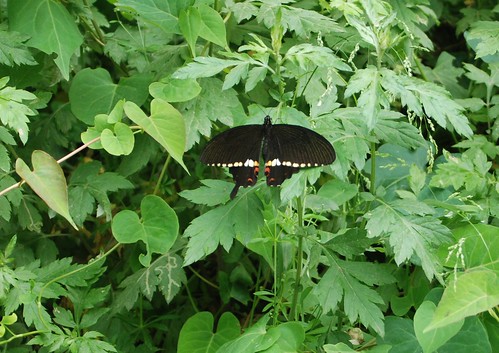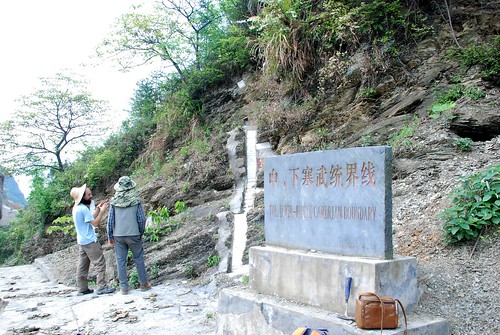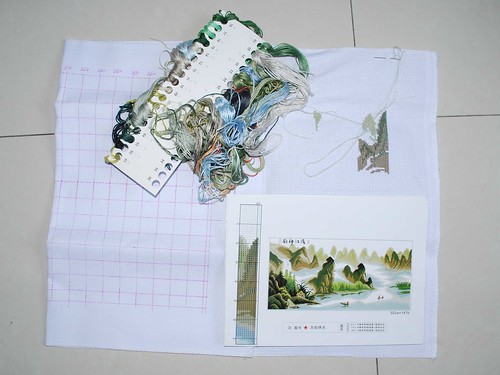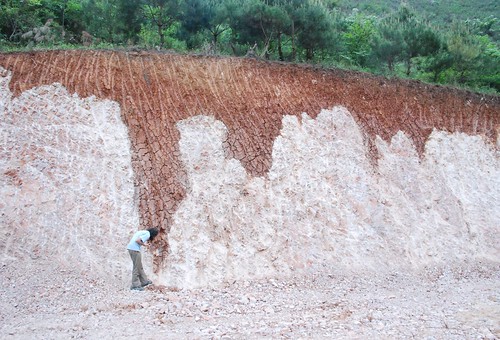Just a very quick post to say that the cardigan didn't come unravelled when it was cut open, and it's now very handy on slightly chilly evenings.
On a totally unrelated topic, we had heard that there is an Irish pub in Nanjing, and had been meaning to go for a while. Last night we finally got there, and it is indeed an Irish pub, with Guinness adverts, beer, chips and an excellent selection of single malts. The barmaids wore kilts. Live music two nights a week, although not the night we went. There were more Westerners there than we’ve seen in one place since we came here. A place we’ll definitely be going back to, although not too often as it’s fairly pricy.
Friday 27 May 2011
freya cardigan 2
Thursday 26 May 2011
A bit on butterflies
Just a quick one, because it's getting late. I suddenly realised I've not done anything about the creepy-crawlies for a while, and thought I'd go for the more palatable variety for once. No, not literally.
Butterflies are everywhere. Most of them, of course, are little white ones, like you've got in your gardens (more or less - I've no idea what the species are). There are, however, a whole stack of other things that are much more impressive... including birdwings, huge fritillaries, and swallowtails. Swallowtails are all over the place, and many different species - the familiar type that occasionally gets spotted in Norfolk (mostly yellow with black speckles), and lots of others. In particular, there are quite a few black ones with a few dashes of colour - this one is Papilio polytes.
The problem is, they never sit still. You see them flying everywhere, but normally high up on the magnolias, and they barely settle for a second. Even when they do, their wings are fluttering so much you can't get close to a picture of them. This one finally took pity on us - it appeared out of nowhere, and plonked itself on a bush next to me. It waited for one photo, then off - but that's a lot better than normal.
Other beasties are coming out too. We're seeing baby mantises quite commonly, huge centipedes and millipedes (had a gorgeous ten-centimetre-long black and yellow one crawling all over me today), and there was also a squashed amblypygid on the pavement. I really, really want to meet a live one of those. If I do, you'll be the first to know, so stay tuned...
p.s. we're getting ready for our summer fieldwork trip to Wales at the moment - flying out in a week's time, and will hopefully see some of you over the next couple of months.
Monday 23 May 2011
Practical geological dating...
On one of the Guizhou forays, we drove most of the way up a mountian to one of the Miao villages at Kaili. We then walked up the rest of way, to get to a building site... walkways, quarries, handrails (necessary in places)... and grand, triumphant proclamations that here, at this very spot, is where the Early Cambrian became the Middle Cambrian.
More accurately, the section is a potential stratotype for the base of the Middle Cambrian (stage C3). What does that mean? Well, one of the basic problems in interpreting the geological past is correlating rocks from one place (or continent) to another. We can't just date everything by using radiometric methods (it's very expensive, only works for certain types of rock, and normally isn't that accurate for single data points), so we've got to correlate them. To do that, you need to pick a point to correlate them with... that's a stratotype.
The stratotypes mark the base of each unit of geological time (or will once they're all decided); there, and only there, are the time units defined. If we say that some rocks in Wales are of Middle Cambrian age, it means that we've got a very good reason for believing that it was deposited after the point in time that is marked on a rock, up a mountain in China (and before wherever the base of the Late Cambrian is defined, of course). At its simplest, the reason might be that it contains a group of trilobites that only appear in China above that level; normally the arguments involve lots of cross-correlation, for example with Norway, then Estonia, then in turn with Iran, then with Malaysia, which finally lets us correlate with China... It's an odd concept, but when you think about it, it's the only good way of doing it. Nothing else is reliable or meaningful for making sure that people in all continents are really talking about the same time.
A committee chooses each site very carefully. Does it have a mixture of different fossils that can be used for correlation? Does it coincide with local changes in sea level or sediment changes that could confuse things? Is the structure chopped about by faults? Is there a good pub nearby? Actually, the latter plays little part, unless you need a two-hour helicopter ride to get to the place (which is a problem for one of the other candidates, in Siberia.)
This one, in the Kaili Formation, isn't too bad. There are lots of trilobites, which are useful for dating things, but few of other groups (no acritarchs, for example, which would be better). It's not been metamorphosed, but there are a few small faults. It's not easy to get to (up a mountain near Kaili City), but could be a lot worse. I understand the decision on which section gets the honour is due in a couple of months... can you all stand the tension?
Saturday 21 May 2011
New cardigan
New cardigan! Pattern is Freyja from Knitting Iceland. It's knitted out of Plötulopi, which is unspun wool. The wool fibres have been arranged in a long strand. The fibres are long enough, and grab onto each other enough, that this does work for knitting, as long as you're gentle with it before it's knitted. After it's knitted it seems to behave just as spun wool.
The observant among you will have noticed that this garment does not yet possess one of the essential characteristics of a cardigan, to wit an opening down the front. This is not an oversight on my part, but part of the pattern. The cardigan isn't worked in the way normal for British patterns, which is to knit the back, both fronts and both sleeves as separate flat pieces, and then sew them all together. This knitting is seamless - the back and front were knitted as one big tube and the sleeves as smaller tubes. All three were joined together at the underarm level, and then the yoke (with the flower pattern) was knitted, with a decreasing number of stitches to make it fit the shoulders. This knitting in the round has several advantages, not least that you don't have to worry about making the front and back pieces the same length. However, in order for this to become a cardigan, it is going to have to be cut open down the front.
Yes, you read that correctly. I am going to take a pair of scissors to my hard work. This is not quite as reckless as it sounds: the process is called steeking (steek is pronounced to rhyme with eek) and is common in Scandinavia, where they know a thing or two about woollens. I am informed that, as long as the edges are reinforced first, the wool fabric will stick together well enough to allow a hem to be put in.
I have never cut my knitting before. I hope it works. Most of the instructions available on the internet recommend having a stiff drink at some point during the proceedings; I think the important thing is to have the drink after cutting, rather than before.
Thursday 19 May 2011
chinese cross stitch
Cross stitch seems to be popular in China; everywhere I've been there is at least one shop selling nothing but cross-stitch kits. Although cross-stitch is an import from the West (as the kit packet helpfully says), the designs are typically Chinese - mountains, cherry blossom, calligraphy, fish... I had to resist the temptation to buy several, as they tend towards the larger sizes (often a metre or so long). I went for this one of mountains and water because Joe likes it. It is remarkably like some of the traditional landscape paintings.
When I bought this kit, the lady in the shop helpfully drew a grid on the cloth for me. I think the lines won't come off (it looked like ordinary ballpoint), so it's a good thing it's on the back of the cloth. The grid does make it easier to keep my place in the design, but somehow it seems a bit like cheating.
As you can see, I have quite some way to go with the sewing yet, but at least it keeps me out of mischief.
Wednesday 18 May 2011
karst
A little light relief from our Guizhou fieldwork. We were driving downhill from Balang Village, after a visit to a possible Cambrian stratotype and one of the localities of the Kaili Biota (for the non-geologists reading this, some very important and serious rocks, which we looked at with due solemnity and reverence). We spotted this exposed in the side of the road and had to stop.
The white rock is limestone of Cambrian age (perhaps 500 million years old), and the red mud is filling in fissures created when the limestone became the land surface much more recently. To cut a long story short, if you rain on limestone, it dissolves and large fissures form. This would not have been a safe place to walk! I can't find any good information on when this dissolution would have happened, but it's probably within the last million years, thus falling into the realm of geography rather than geology.
The red mud filling in the fissures contained small bits of bone, but nothing recognisable.
Thursday 12 May 2011
A bit about Guizhou
The first thing to say about this part of country is that it's absolutely stunning. Way down south, almost at the border with Viet Nam, it's getting close to tropical, and has never had glaciers. The rock is a mixture of limestone and mudstone, and when that weathers over millions of years, you get spectacular scenery... All those over-the-top Chinese landscapes you've seen? Yep, this is where they come from.
Actually, a lot of South China has similar mountains, but around here there are just more of them. They're not all that high - only about 2000 m, mostly - but the whole province is one mass of hills. Steep hills, with deep valleys and no straight roads.
The result of this is that Guizhou is traditionally known as the least developed province - for centuries, large parts were mostly impenetrable, and it was left to the natives. The native population is one of China's ethnic minorities, the Miao (at least in the east; western Guizhou is mostly Dong, I believe).
The Miao are a relatively traditional people, and their farming-dominated villages seem to be of two sorts: either on rivers in the narrow valleys, or way up high on the mountain ridges. We've got some more photos of these villages for later, but this one shows typical river scenery. The bamboo-roofed canoes are a common element. To imagine yourself there, you need to picture sweltering temperatures and humidity, exotic butterflies and strange birds, and the odd grunting water buffalo.
As a final thought, a lot of Guizhou is now opening up. Ridiculous highways are being driven straight through the hills and over the valleys, and entire hills are being razed if they get in the way. China is investing heavily in getting Guizhou into the current century, which is leading to tourism, prosperity, and a huge great galumphing stack of outcrops. There are reasons why the province has so many important fossil deposits suddenly appearing (e.g. Kaili Biota, Balang Fauna, and those cute little plesiosaurs you've probably seen on the internet). While the benefits to the local population are clear, we hope that the place doesn't lose most of its beauty in the process.
Friday 6 May 2011
fields
We're back from fieldwork! Remarkably successful - we have unexpected sponges, some nice graptolites and a few more surprising things. Also some interesting bits of geology, more of which later.
Today we're recuperating, then starting the long process of writing up everything we found.
This photograph shows a typical view in rural Guizhou. There are many high, steep mountains, making farmable land in limited supply. The locals are very good at making use of every part of it - even some of the road verges will have a dozen cabbages planted.








